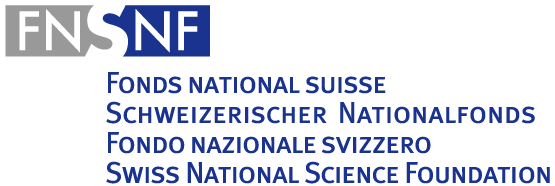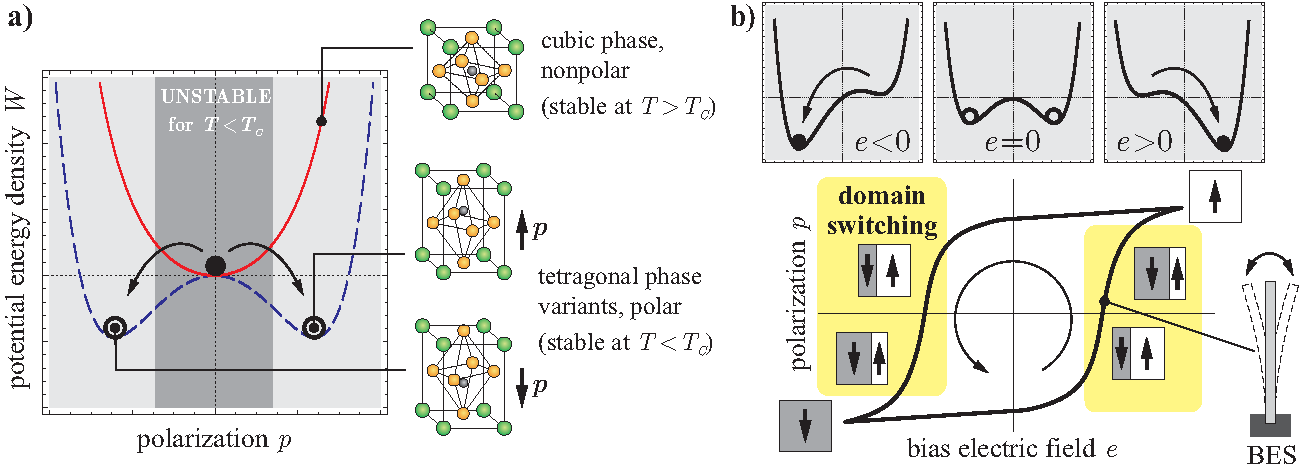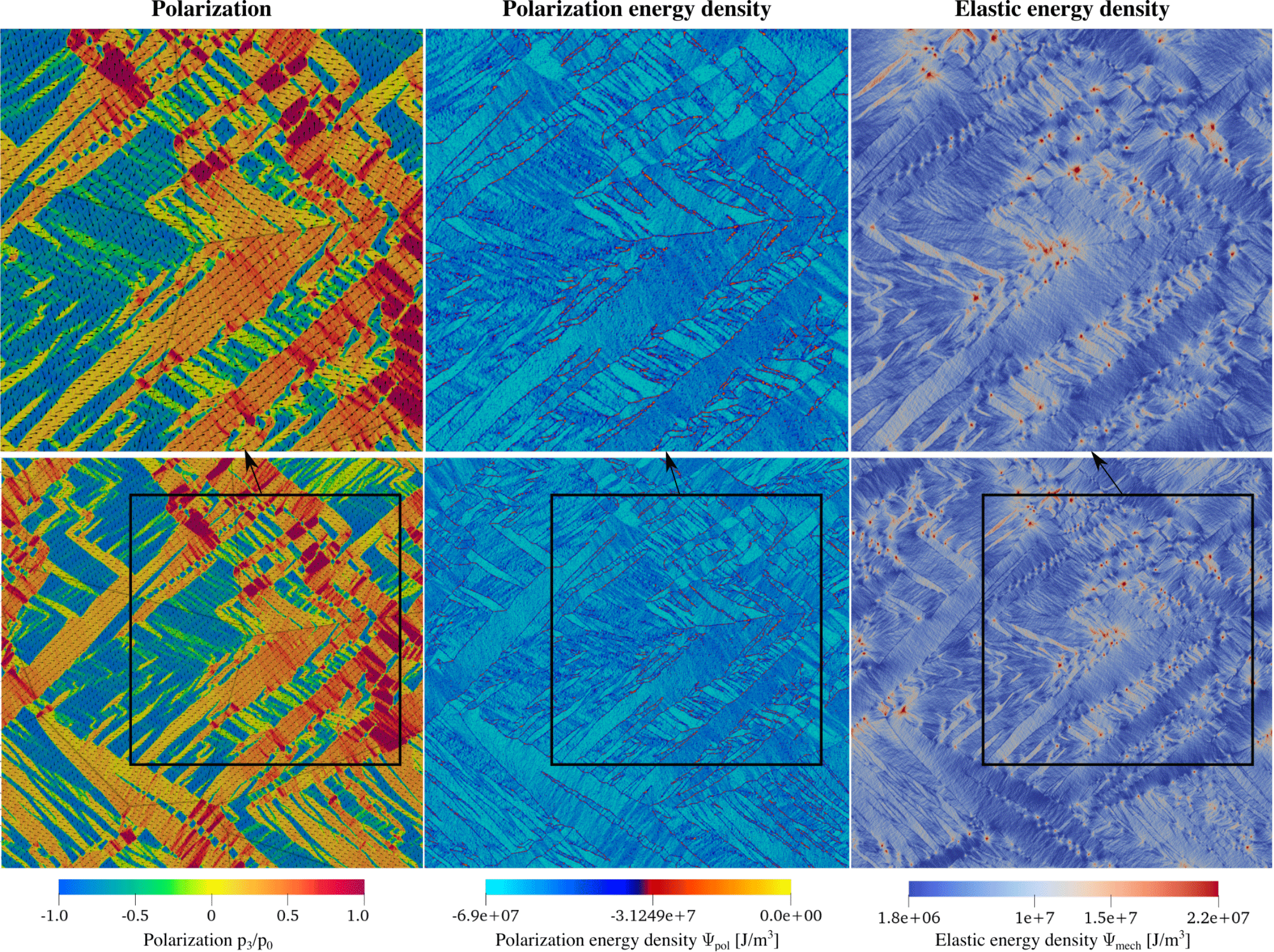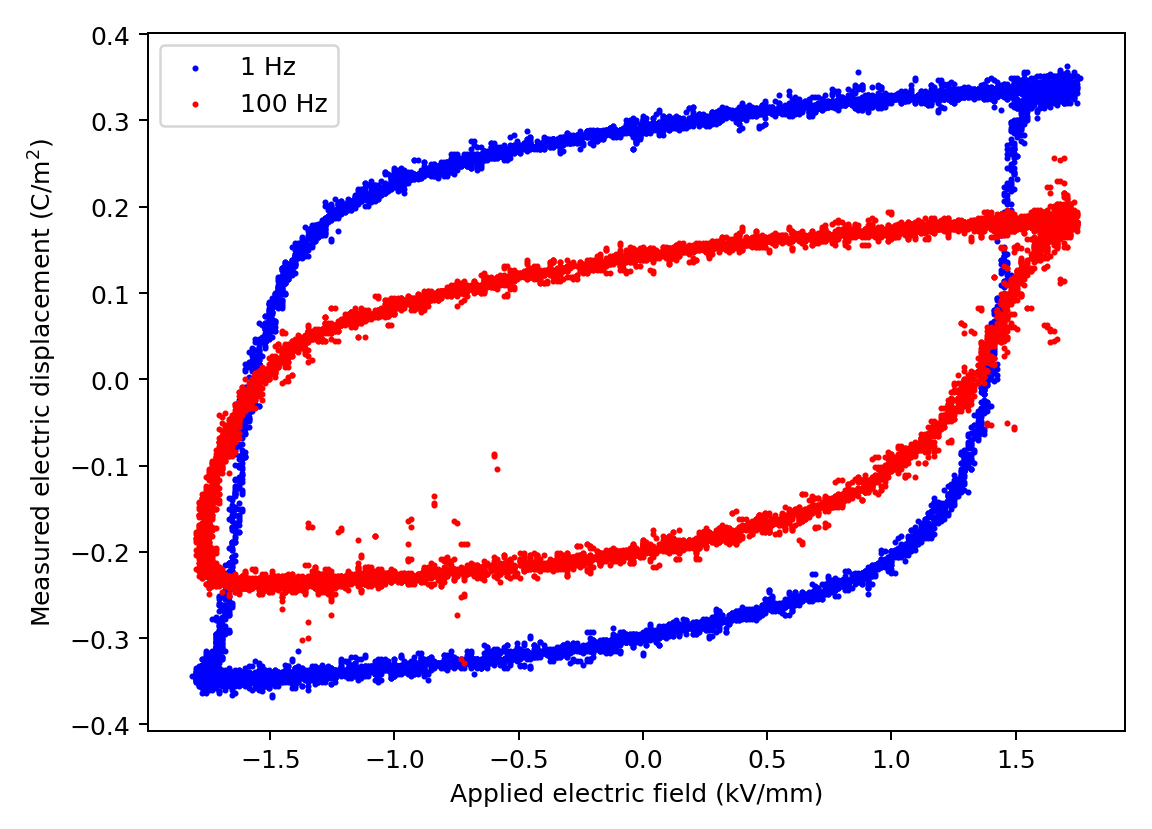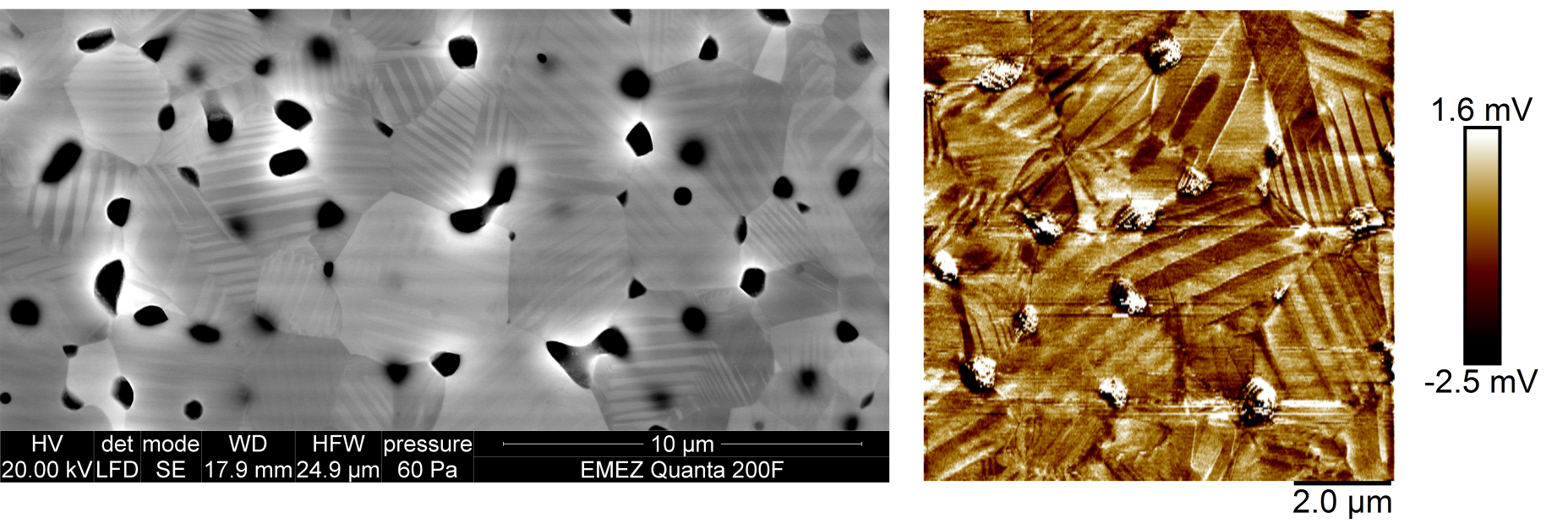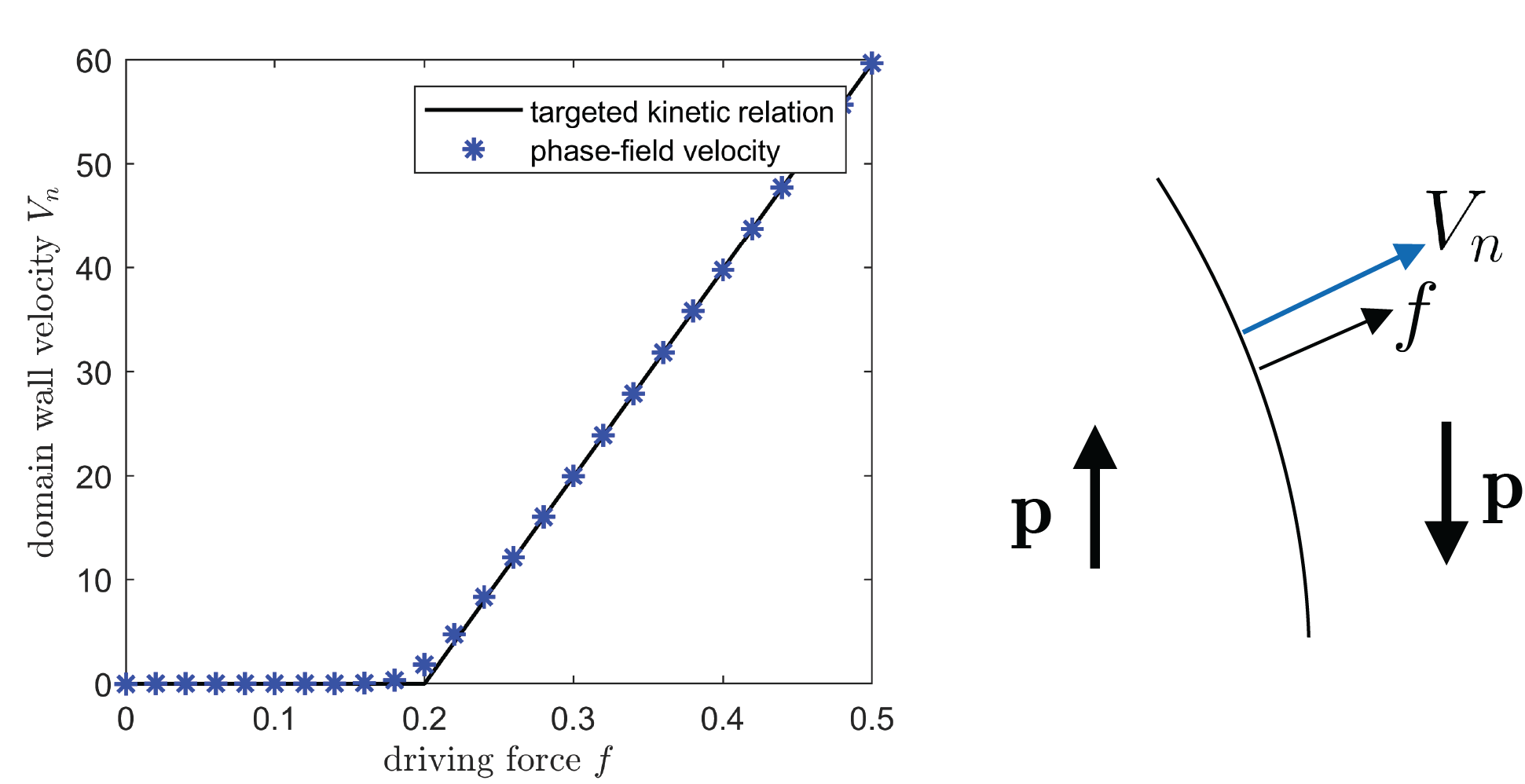Ferroelectric Ceramics
The thermo-electro-mechanical coupling and the unique property to permanently alter their atomic-level electric dipole moment (polarization) makes ferroelectric ceramics a promising active material for various engineering applications, e.g., in sensors, actuators, storage devices, energy converters, medical and communication industry. In contrast to the well-known piezoelectric materials, ferroelectrics are not limited to small electromechanical loads and can exhibit large-strain actuation under strong electric fields, which exceeds the linear strain-electric field regime of piezoelectrics and results in a characteristic hysteresis. While the linear response is well understood, the complex nonlinear response is far from being understood, which necessitates the theoretical, computational, and experimental reserach pursued in our lab.
The characteristic physics of ferroelectric ceramics originates from their perovskite crystal structure at the atomic level. The atomic unit cell favors a low-symmetry Bravais lattice below a transition temperature, the so-called Curie temperature. Depending on the specific composition of the ferroelectric ceramic, the crystallographic symmetry is generally tetragonal, rhombohedral, or orthorhombic. We use Landau-Devonshire theory to model the low-symmetry crystal structure phenomenologically (e.g., of a tetragonal phase). The underlying energy (or enthalpy) landsapce is multi-welled where each minimum represents one equilibrium polarization state. Due to ordering of multiple, polar unit cells, regions of homogeneous polarizatio, ferroelectric domains, emerge, which are separated by domain walls.
In continuum-level simulations, domain walls are usually described as diffusive interfaces in a phase-field setting or as sharp interfaces in energy-minimizing patterns. Minimization of the non-convex energy under compliance of the mechanical and ferroelectric compatibility yields the typical laminate patterns of ferroelectric domains (shown further below). Applying an electrical field tilts the multi-well potential such that one polarization state (minimum) is lower in energy and hence preferred by the material. Ferroelectric switching is an energy lowing mechanism that occurs mainly by growth of an existing, low-energy domain (domain wall motion) or by the nucleation of new, low-energy domains. Both mechanisms coexist at the micro- and nanoscales and play a key role in the macroscopic kinetics of polarization switching. Therefore, the complex coupling mechanisms in ferroelectric materials require us to consider multiple length scales ranging from the atomic level across the polycrystalline mesoscale to the macroscopic device level (and, of course, the associated time scales).
In our research, we pursue multiscale modelling to bridge the gap between rate-dependent kinetics at the lower scales and the macroscopic hysteresis of ferroelectric ceramics. In addition, we perform experiments using Broadband Electromechanical Spectroscopy (BES), which was developed in our lab, to measure the dynamic stiffness and damping of ferroelectrics under combined mechanical, electrical, and thermal loads that help us understand the experimental data and predict the response of new materials and structures with optimal performance.
One of our goals in the study of the viscoelastic properties of ferroelectric ceramics is to create materials with both high stiffness and high damping and to create electro-active solids and structures. A myriad of engineering structures (e.g. aircraft and spacecraft) are simultaneously subjected to large mechanical loads and vibrations. Incorporating materials with high stiffness and high damping into such structures can dramatically reduce weight and complexity. Yet, materials with both high stiffness and high damping are a rare find. We have demonstrated (see above) that inducing ferroelectric switching in ferroelectric ceramics can be exploited to considerably vary the effective stiffness and damping of the material. The BES setup, which measure the dynamic stiffness and damping of ferroelectrics under combined mechanical, electrical, and thermal loads, is further used to experimentally measure the dissipation at each point on the ferroelectric hysteresis. Our experiments further explore active structures with set-and-hold functionality based on controlled domain switching.
Finite temperature
An open challenge is the temperature-dependent kinetics of ferroelectric switching, which emerges on the atomic level but has a strong impact on the mesoscale domain wall motion and nucleation. Based on a phase-field (diffuse-interface) description of ferroelectricity and its numerical implementation via FFT-based spectral homogenization, we have extended the ferroelectric constitutive model to account for the external page effects of finite temperature.
We have proposed a new constitutive model using statistical mechanics to consider atomic-level thermal lattice vibrations as well as by modifying the underlying Ginzburg-Landau potential to depend on temperature. Results indicate that a linear interpolation of the Landau energy coefficients is a suitable approach to predict the temperature-dependent spontaneous polarization accurately over a broad temperature range. Lowering the energy barrier at finite temperature by the aforementioned methods also leads to a better agreement with measurements of the bipolar hysteresis. More importantly, our research on tetragonal lead zirconate titanate (PZT) revealed that the combined effect of thermal fluctuations and temperature-dependent energetics leads to a competition between nucleation and growth of needle-like domains. While at high temperatures the energy landscape flattens and thermal lattice vibrations promote the nucleation of new domains, polarization switching at low temperature is primarily driven by the growth of existing domains, since barrier crossing events by Brownian motion are less likely to occur in a steep energy landscape.
The implications of finite temperature are particularly interesting to study at the mesoscale, where the complex interaction of thermal fluctuations and microstructural imperfections (such as grain boundaries in a polycrystal) causes the localization of nucleation in regions of material heterogeneity or local stress concentrations and hence result in faster polarization reversal and a more realistic domain pattern evolution, as showed above.
Experiments: In-situ electromechanical behavior of bulk ferroelectric materials
We perform fundamental experiments to understand bulk polarization switching kinetics and the coupled response in ferroelectric materials. An in-house experimental setup allows the measurement of polarization and mechanical strains of millimeter-scale cantilever beam samples in-situ, while applying large electrical fields and small mechanical loads through the BES setup. We thus gain insight into the effects of electrical loading rates, composition and temperature on the polarization kinetics as well as into the viscoelastic material behavior of different types of ferroelectric crystals and ceramics.
Experiments: Imaging microscopic ferroelectric domains
The measured bulk kinetics of polarization switching are affected by the nucleation and growth of microscopic domains with different polarization states compared to the surrounding crystal. We collaborate with scientists in the Laboratory for multifunctional ferroic materials and the Scientific Center for Optical and Electron Microscopy (ScopeM) user facility on the Hönggerberg campus of ETHZ to make micro-scale measurements of crystal orientations and polarization distribution in our samples before and after loading, which serves as an essential input to our modeling efforts.
A phase-field model with general domain wall kinetics
Existing phase-field models for polarization switching in ferroelectrics are almost exclusively based on the Allen-Cahn equation, which assumes a linear kinetic relation between the thermodynamic driving force exerted on a domain wall and its normal velocity. By contrast, experimental observations rather suggest a nonlinear stick-slip relation between velocity and driving force, which results from the pinning of domain walls by defects at low applied electric fields. We develop an alternative phase-field model for the polarization evolution, which - by incorporating both nonlinear domain wall kinetics and an independent criterion for nucleation - permits a physically-informed description of the domain evolution process. This new formulation paves the road for an accurate account of the sequence of domain nucleation and growth underlying the macroscopic response of ferroelectrics. It further provides a suitable model for understanding the rate dependence of polarization switching.
This research is sponsored by the Swiss National Science Foundation (SNSF).
